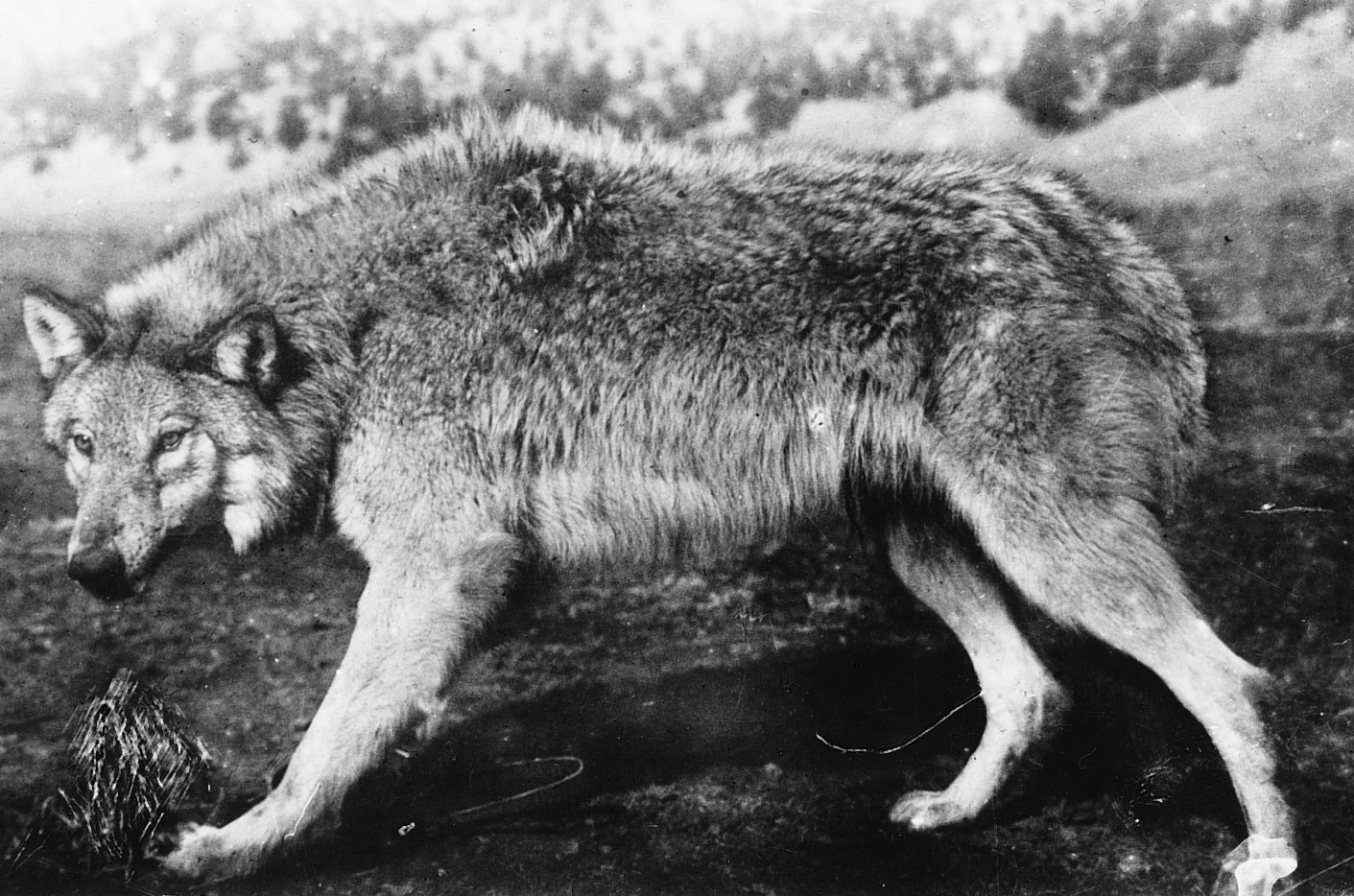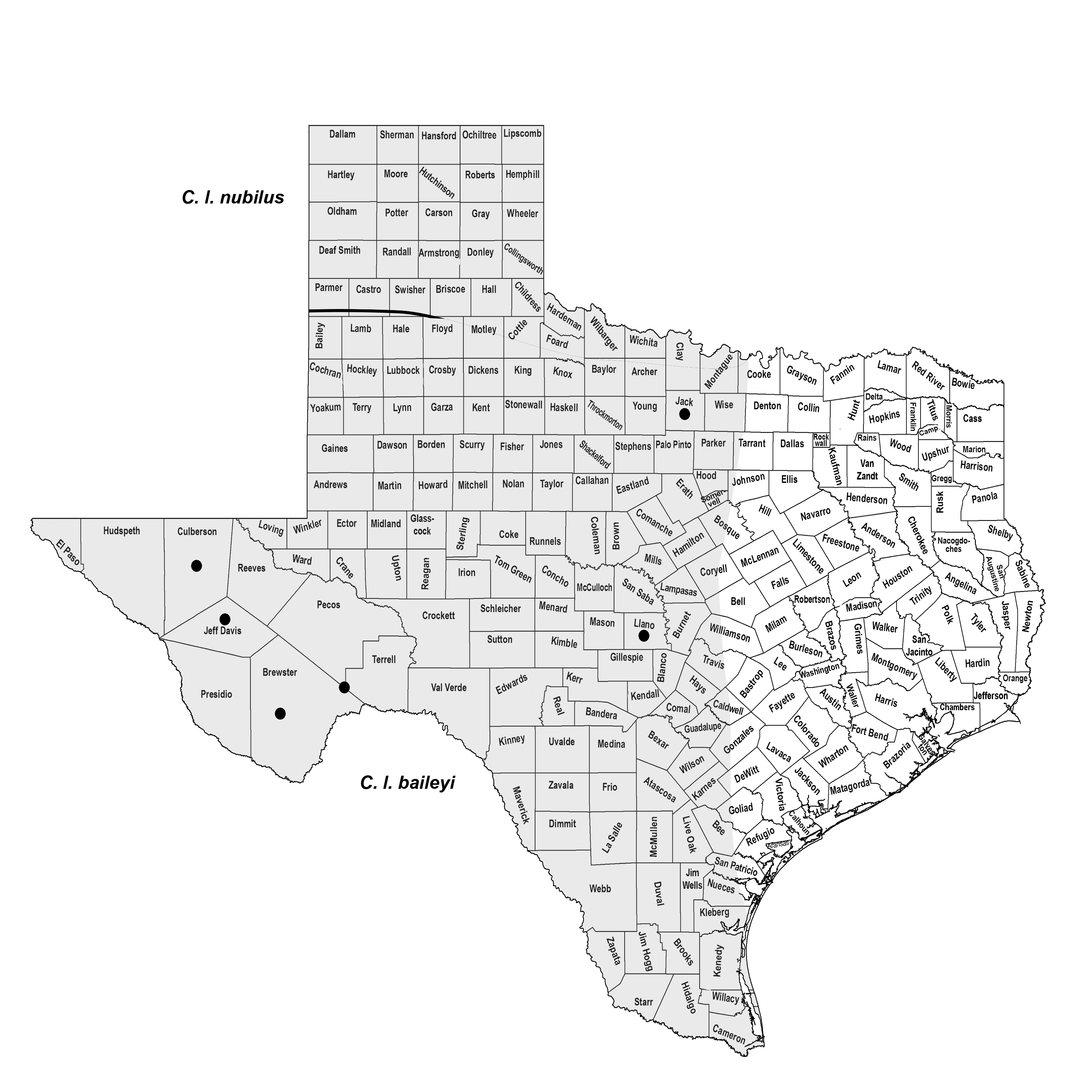GRAY WOLF
Canis lupus Linnaeus 1758
Order Carnivora : Family Canidae
DESCRIPTION. A large, dog-like carnivore with heavy, broad skull and muzzle; height at shoulder slightly greater than at rump, legs relatively long (compared with a coyote); tail relatively short; upperparts grayish, usually heavily washed with blackish, occasionally predominantly blackish; head more or less tinged with cinnamon; underparts whitish or buffy; tail black tipped; ears short and more rounded than in a coyote; feet much larger than in a coyote. Dental formula: I 3/3, C 1/1, Pm 4/4, M usually 2/2, occasionally 3/3, 3/2, or 2/3 × 2 = 40, 42, or 44. External measurements of a male: total length, 1.6 m; tail, 419 mm; hind foot, 267 mm; of a female, 1.5 m-360 mm-269 mm. Weight of males, 30–80 kg; of females, 20–60 kg.

DISTRIBUTION. The gray wolf formerly ranged over the western two-thirds of the state, but native populations are now extirpated in Texas and much of the western United States. Recent introductions into Yellowstone National Park, southern Arizona, and western New Mexico have been successful. The last authenticated reports of gray wolves in Texas are of two males, the skulls of which were donated to Sul Ross State University. According to James Scudday of that university, one wolf was shot 5 December 1970 on the Cathedral Mountain Ranch, 27 km (17 mi.) south of Alpine, Brewster County. The other was trapped several days before 28 December 1970 on the Joe Neal Brown Ranch, at about the point where Brewster, Pecos, and Terrell counties meet. It is probable that these two individuals were migrants from Mexico.

SUBSPECIES. In 1983 Michael Bogan and Patricia Mehlhop (US Geological Survey) reviewed the systematic status of gray wolves in southwestern North America, and we have followed their arrangement for Texas, recognizing two subspecies, C. l. nubilus in the northern Panhandle and C. l. baileyi in the southwestern half of the state. The third subspecies recognized by these scientists, C. l. youngi, does not occur in Texas. Of the three subspecies, the most distinctive, both morphologically and genetically, is the Mexican gray wolf (C. l. baileyi).
HABITS. The gray wolf inhabits forests, brushlands, or grasslands, preferring broken, open country in which suitable cover and denning sites are available. Formerly, wolves occurred in the grassland plains where they relied on bison for their chief food supply.
Gray wolves have incredible stamina and endurance and can travel for hours without fatigue. They usually travel and hunt in packs, occasionally in pairs or singly, relying on their own endurance or numbers to wear down the intended large prey. The family group constitutes the nucleus of the pack, to which bachelor friends or members of another family may be added. The usual pack consists of 6–10 individuals, but packs twice that size are not uncommon. Packs with as many as 50 individuals have been recorded.
Under normal conditions, wolves feed on large herbivores—deer, elk, and pronghorns—but when large prey is scarce they feed on mice, ground squirrels, and rabbits. When natural prey items are not available, wolves may utilize domesticated livestock as a resource. The extirpation of the gray wolf over most of its former range reduced predator pressure on big game species, such as deer, which in part created a serious problem of overpopulation of this game animal in several localities in Texas.
Wolves typically mate for life; however, within a pack, only the alpha male and female mate and produce pups. The breeding season begins in late December and continues through February; the gestation period is about 63 days. The young, usually four to six in number, are whelped in late winter or early spring in a den dug into a hillside or cut bank or in a crevice in a rocky bluff. At first the young are blind, naked, and helpless, but they grow rapidly. At about 9 days of age their eyes open, at which time they are covered by wooly, juvenile fur. Pups spend the first months learning to hunt mice and other small prey; as they mature they begin to hunt with adult members of the pack. By October they are nearly full grown. Females are sexually mature when 2 years old; males mature about a year later.
POPULATION STATUS. Extinct. Gray wolves are extinct in Texas and are not likely to return unless they are reintroduced or migrate from populations in Mexico.
CONSERVATION STATUS. The IUCN lists the gray wolf as a species of least concern. However, many populations and subspecies are considered severely threatened. The gray wolf has been listed as endangered by TPWD and USFWS. Recently, however, the federal government has been proposing to delist the more northern populations of the gray wolf while at the same time listing the Mexican gray wolf (C. l. baileyi) as endangered. Wolves have been successfully reintroduced in Yellowstone National Park, southwestern New Mexico, and in Arizona, demonstrating such a model can be successful. There have been some discussions of reintroducing wolves to Big Bend National Park, but no current action is underway.
From The Mammals of Texas, Seventh Edition by David J. Schmidly and Robert D. Bradley, copyright © 1994, 2004, 2016. Courtesy of the University of Texas Press.
Natural Science Research Laboratory
-
Address
Museum of Texas Tech University, 3301 4th street, Lubbock, TX 79409 -
Phone
806.742.2486 -
Email
nsrl.museum@ttu.edu

